The Cross-culture Research between China and America on Family Education
大学跨文化英语综合教程2u2作文

大学跨文化英语综合教程2u2作文Cross-Cultural English Integrated Course 2u2 EssayThe field of cross-cultural communication has become increasingly important in today's globalized world. As individuals from diverse cultural backgrounds interact more frequently in academic, professional, and social settings, the ability to effectively navigate these intercultural exchanges is crucial. This essay will explore the key aspects of cross-cultural communication and the benefits of incorporating a cross-cultural approach into English language education.One of the fundamental aspects of cross-cultural communication is the recognition and understanding of cultural differences. Every culture has its own set of values, beliefs, and norms that shape the way individuals perceive and interact with the world around them. These cultural differences can manifest in various ways, such as communication styles, nonverbal behaviors, and approaches to problem-solving. Effective cross-cultural communication requires the ability to identify and appreciate these differences, rather thanmaking assumptions or judgments based on one's own cultural lens.In the context of English language education, a cross-cultural approach can provide students with the necessary skills and knowledge to navigate diverse linguistic and cultural environments. By exposing students to a range of cultural perspectives and communication styles, they can develop a more nuanced understanding of the English language and its use in various contexts. This not only enhances their linguistic competence but also fosters intercultural competence, enabling them to communicate effectively with individuals from different cultural backgrounds.Moreover, a cross-cultural approach to English language education can have significant benefits for students' personal and professional development. In today's interconnected world, the ability to communicate effectively across cultures is highly valued in a wide range of fields, from business and international relations to academia and the arts. By incorporating cross-cultural communication into the curriculum, students can gain a competitive edge in the job market and be better prepared to succeed in their future endeavors.One key aspect of a cross-cultural English language curriculum is the inclusion of authentic materials and resources that reflect diverse cultural perspectives. This can include literature, films, news articles, and other media that showcase the richness and complexity ofdifferent cultural traditions and communication styles. By engaging with these materials, students can develop a deeper understanding of the cultural context in which the English language is used, and learn to navigate the nuances of cross-cultural communication.Additionally, a cross-cultural approach to English language education should emphasize the development of intercultural competence. This involves the ability to recognize and respect cultural differences, to communicate effectively with individuals from diverse backgrounds, and to adapt one's communication style and behavior to suit the cultural context. By focusing on these skills, students can become more adept at navigating the challenges and opportunities presented by cross-cultural interactions.Another important aspect of a cross-cultural English language curriculum is the incorporation of collaborative learning and group activities. By working in diverse teams, students can learn to navigate the complexities of cross-cultural communication, develop empathy and understanding for different perspectives, and practice the skills necessary for effective collaboration in a globalized world.Furthermore, a cross-cultural approach to English language education should also address the role of language in the construction and expression of cultural identity. As students explore the relationship between language and culture, they can gain adeeper appreciation for the ways in which language shapes and is shaped by cultural norms and values. This understanding can not only enhance their linguistic skills but also foster a greater respect for cultural diversity and a commitment to intercultural understanding.In conclusion, the incorporation of a cross-cultural approach into English language education is crucial in today's globalized world. By exposing students to diverse cultural perspectives, developing their intercultural competence, and emphasizing the relationship between language and culture, educators can equip students with the skills and knowledge necessary to navigate the complexities of cross-cultural communication. This, in turn, can lead to greater personal and professional success, as well as a more just and equitable global society.。
cross-culturalco...

cross-culturalco...第一篇:cross-cultural communication辅导跨文化交际胡文仲视频演讲稿(含重点和PPT内容)cross-cultural communication辅导(2)跨文化交际胡文仲视频演讲稿(含重点和PPT内容)Hello, every one, this is the second talk, intercultural communication.In this talk, we will be talking about verbal communication.verbal communication is communication using words.we will be talking about language and culture and their relationships.There is a very close relationship between language and culture.In Arab, there are many words related to camel.Because camel used to be a very important part of the life of Arabs.In the Chinese language, there is an elaborate system of kinship terms.Because Chinese families used to be large and hierarchical.We care about whether the grandmother is on the father side or on the mother side.If it is on the side of mother, it is called外祖母.If it is on the side of the father, it is called祖母.But in English, normally, they do not have such distinction.In Chinese, we make a distinction between哥哥and弟弟.Because哥哥has more authorship than弟弟.But in English, normally, they just use brother to refer to either哥哥or弟弟.From this we can see, language is very much influenced by nguage is a mirror of culture, because language reflects human relationships.It reflects the way the society operates.Firth thing is language of kinship terms is a reflection of our family system.As a matter of fact, language is a part of the culture or we can say language is culture.There is no doubt there is a very close relationship between language and culture.Some people go even further and claim that language determines the way we think.This is what wecall linguistic determinism(语言决定主义——语言决定了我们思考的方式。
如何使团队更好的和有效的跨文化沟通英文

Many enterprises have tended to be flattened, making the cross-sectoral,cross—cultural communication between the communication and cooperation is more frequent。
Departments have equal status,there is no superior—subordinate relationship,supposedly interpersonal communication should be relatively easy。
But the reality of the situation is that the cost of coordination between departments is quite high,the cost of such communication exists not only in the large—scale organization,is also plagued by small and medium—sized companies.Many things, in fact, is not complicated, but the poor communication between people,that you want to move out of the boss,even to coordinate boss’s boss. Around in a big circle, and take a long detour, you and me his valuable time wasted。
As the saying goes, a waste of time is a waste of money,this is actually a high interpersonal communication costs. There is a saying that very directly,to move out of the boss to coordination,is his ability to communicate incompetent。
跨文化研究
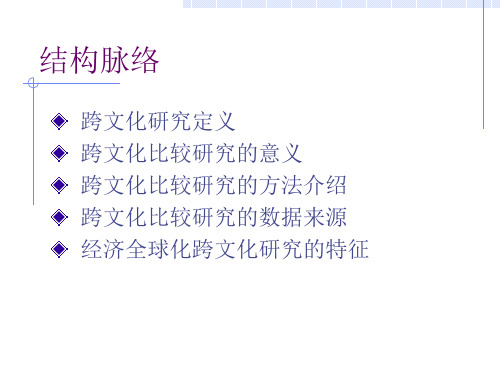
Cross-cultural survey research
(1)采样:受到文化环境的影响。研究者必须考虑到所 采用的采样框架是否可行。如果是通过邮寄或者电话 采访的方式,那么研究者就必须了解邮寄或者电话服 务的质量。他们需要知道人们流动的频率,居民生活 的质量,在一个生活区中的人数,电话的覆盖面等。
因此,跨文化比较研究无疑是研究人类行为方法中的 一种重要的方法。
跨文化比较研究的方法介绍
跨文化比较研究所采用的方法包括我们前面所 介绍过的一些社会研究方法,包括调查研究 (survey research),实地研究(field research,包括参与观察、直接观察与个案研 究)。而在后者则更多的采用参与观察。
调查是不一样的,通常会在数量上与重要性上 非常不同。因此研究必须仔细考虑所采用的调 查是否是最好的方法。
Cross-cultural survey research
调查研究之前:要在不同的文化中作调查研究,研究 者就必须首先拥有关于该文化的规则、活动以及习俗 的深度知识。如果缺乏这些知识,那么在调查过程中 与解释结果时是很容易犯严重错误的。这样就对研究 者提出了很高的要求。这就要求研究者,他不仅仅是 要懂得另一种语言,他还必须是多文化的,他应该能 彻底了解文化并熟悉调查方法。
结构脉络
跨文化研究定义 跨文化比较研究的意义 跨文化比较研究的方法介绍 跨文化比较研究的数据来源 经济全球化跨文化研究的特征
跨文化研究的定义
跨文化研究法(Cross-cultural study)是利用各种不同 文化为样本,以其资料作比较研究,从而探索不同文化 背景的变量间的关系的科学方法。
关于跨文化的英文文献
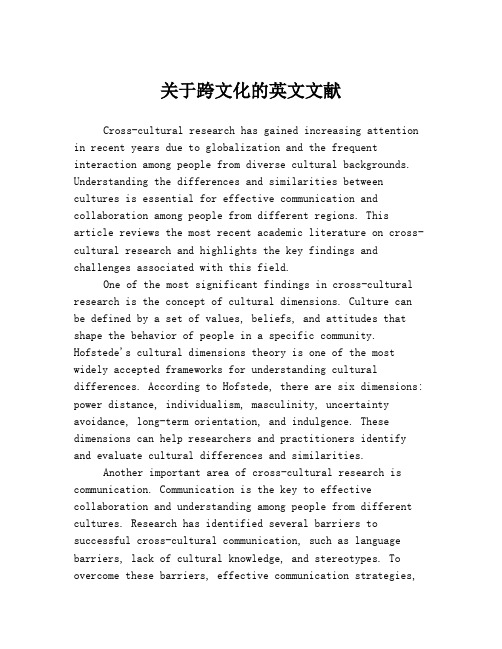
关于跨文化的英文文献Cross-cultural research has gained increasing attention in recent years due to globalization and the frequent interaction among people from diverse cultural backgrounds. Understanding the differences and similarities between cultures is essential for effective communication and collaboration among people from different regions. This article reviews the most recent academic literature on cross-cultural research and highlights the key findings and challenges associated with this field.One of the most significant findings in cross-cultural research is the concept of cultural dimensions. Culture can be defined by a set of values, beliefs, and attitudes that shape the behavior of people in a specific community. Hofstede's cultural dimensions theory is one of the most widely accepted frameworks for understanding cultural differences. According to Hofstede, there are six dimensions: power distance, individualism, masculinity, uncertainty avoidance, long-term orientation, and indulgence. These dimensions can help researchers and practitioners identify and evaluate cultural differences and similarities.Another important area of cross-cultural research is communication. Communication is the key to effective collaboration and understanding among people from different cultures. Research has identified several barriers to successful cross-cultural communication, such as language barriers, lack of cultural knowledge, and stereotypes. To overcome these barriers, effective communication strategies,such as active listening, cultural sensitivity, and nonverbal communication, have been proposed.Furthermore, cross-cultural research has highlighted the importance of cultural intelligence (CQ) in today'sglobalized world. CQ is a set of skills and knowledge necessary for successful cross-cultural interaction. These skills include knowledge of cultural norms, customs, and values, as well as empathy and openness to learning aboutother cultures. Research has shown that individuals with high CQ are more successful in cross-cultural interactions andhave better job performance in global organizations.However, cross-cultural research is not without its challenges. One of the main challenges is the risk ofcultural stereotypes and bias. Researchers must be carefulnot to generalize cultural traits and behaviors without considering individual differences and variations within cultures. Moreover, methodological issues, such as sampling bias and measurement error, can also affect the validity and reliability of cross-cultural research findings.In conclusion, cross-cultural research is essential for understanding and appreciating diversity among cultures. By identifying cultural differences and similarities,researchers and practitioners can develop effectivestrategies for communication and collaboration among people from different regions. However, challenges associated with cross-cultural research, such as cultural stereotypes and bias, must be addressed to ensure valid and reliable findings. Future research should aim to develop more nuanced and sophisticated approaches to understanding culture and its impact on behavior and interaction.。
cross-cultural research
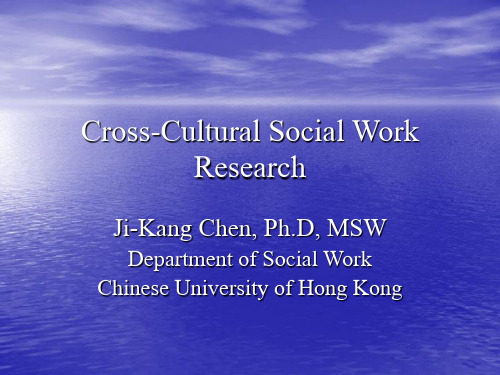
How to resolve the challenges in cross-cultural social work research
1. Good relationship with community leaders
For example: get endorsement from Indian American tribe leader. 2. Confidentiality For example, do not make public the specific tribe or community.
How to resolve the challenges in cross-cultural social work research
Appropriate cultural sensitivity 6. Use or train culturally competent interviewers. 7. Bilingual staff 8. Understanding cultural factors influencing participation 9. Anonymous enrollment(for example, AIDS/HIV populations) 10. Translation Validity
How to resolve the challenges in cross-cultural social work research
14. Tracking method (1) phone tracking (2) mail tracking (3) agency tracking (4) field tracking 15. Anchor point Especially for homeless population
across-culturalc...

作者:于倩
学位授予单位:对外经济贸易大学
引用本文格式:于倩A CrosS-cultural Comparison of Social Network Sites between China and the US[学位论文]硕士 2012
英语选必二第5单元作文

跨文化交流中的误解与桥梁In the era of globalization, cross-cultural communication has become an inevitable trend. However, differences in language, culture, and values often lead to misunderstandings and conflicts. It is crucial tounderstand the reasons behind these misunderstandings and find ways to bridge the cultural divides.Language is the most fundamental tool of communication. However, language barriers can be a significant obstacle in cross-cultural communication. For example, words andphrases may have different meanings or connotations in different cultures. This can lead to misunderstandings and misinterpretations. Additionally, non-verbal communication, such as facial expressions, gestures, and body language, also vary across cultures. These differences can cause confusion and misinterpretation if not properly understood. Cultural differences can also lead to misunderstandings. Each culture has its unique values, beliefs, and norms. These differences can affect how people interpret and respond to situations. For example, some cultures may value individualism and independence, while others may emphasizecollectivism and conformity. Such differences can lead to misunderstandings when people from different cultures interact.To bridge the cultural divides, it is essential to have a culture-sensitive approach. This means being aware of and respectful of the differences in culture, language, and values. It also involves the willingness to learn and adapt to new ways of communicating. For example, when communicating with someone from a different culture, it is helpful to ask questions and seek clarification to avoid misinterpretations. Additionally, it is important to be tolerant of different ways of communicating and not judge others based on their cultural background.Moreover, education and awareness are crucial in promoting cross-cultural understanding. Schools and organizations should provide opportunities for people to learn about different cultures and languages. This can help foster a more inclusive and tolerant society where people from different backgrounds can communicate effectively and respectfully.In conclusion, cross-cultural communication can be challenging due to language and cultural differences. However, by understanding the reasons behind these misunderstandings and adopting a culture-sensitive approach, we can bridge the divides and promote effective communication. Education and awareness are also crucial in fostering a more inclusive and tolerant society. By working together, we can overcome the challenges of cross-cultural communication and create a more connected and understanding world.**跨文化交流中的误解与桥梁**在全球化的时代,跨文化交流已经成为不可逆转的趋势。
on cross-culture英语作文
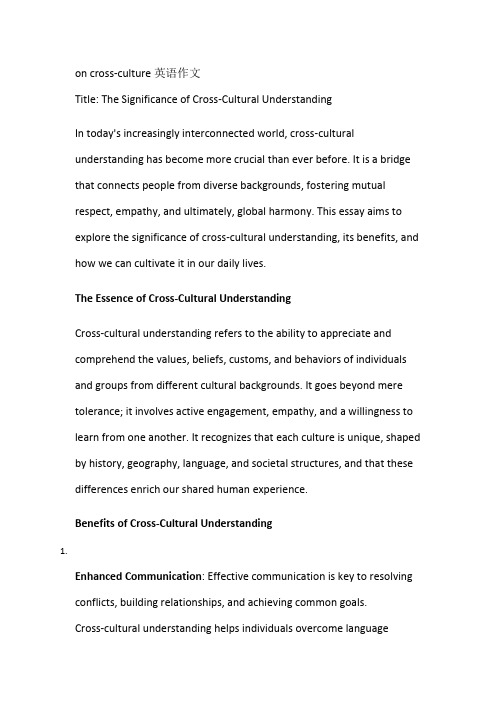
on cross-culture英语作文Title: The Significance of Cross-Cultural UnderstandingIn today's increasingly interconnected world, cross-culturalunderstanding has become more crucial than ever before. It is a bridge that connects people from diverse backgrounds, fostering mutualrespect, empathy, and ultimately, global harmony. This essay aims to explore the significance of cross-cultural understanding, its benefits, and how we can cultivate it in our daily lives.The Essence of Cross-Cultural UnderstandingCross-cultural understanding refers to the ability to appreciate andcomprehend the values, beliefs, customs, and behaviors of individuals and groups from different cultural backgrounds. It goes beyond mere tolerance; it involves active engagement, empathy, and a willingness to learn from one another. It recognizes that each culture is unique, shaped by history, geography, language, and societal structures, and that these differences enrich our shared human experience.Benefits of Cross-Cultural Understanding1.Enhanced Communication: Effective communication is key to resolving conflicts, building relationships, and achieving common goals.Cross-cultural understanding helps individuals overcome languagebarriers, misunderstandings, and stereotypes, enabling them tocommunicate more effectively across cultural divides.2.3.Promotes Peace and Harmony: In a world fraught with tensions and conflicts, cross-cultural understanding fosters a deeper appreciation for diversity and the value of peaceful coexistence. It encourages individuals to see beyond their immediate differences and work towards shared objectives.4.5.Economic Growth: In the globalized economy, businesses frequently operate across borders, necessitating cross-cultural competence.Understanding cultural nuances can help companies adapt theirproducts, services, and marketing strategies to suit local markets,leading to increased sales and profitability.6.7.Personal and Professional Development: Embracing different cultures broadens one's horizons, enriching personal experiences and enhancingcreativity. In the workplace, cross-cultural skills are highly valued,opening doors to international opportunities and advancing careers.8.Cultivating Cross-Cultural Understanding1.Education: Incorporating multicultural content into curricula is crucial. It exposes students to diverse perspectives, fostering empathy andcuriosity about other cultures.2.3.Travel and Immersion: Firsthand exposure to different cultures through travel or living abroad is invaluable. It allows individuals to experience the daily lives of others, observe cultural practices, and engage inmeaningful conversations.4.5.Media and Technology: The internet and media provide powerfulplatforms for sharing cultural stories and perspectives. Engaging with diverse content can help broaden one's understanding of other cultures. 6.7.Open-Mindedness and Respect: Cultivating an open mind and a deep respect for cultural differences is essential. This involves activelylistening, avoiding assumptions, and being willing to learn from others. 8.9.Dialogue and Exchange Programs: Organizing cultural exchangeprograms, workshops, and forums encourages dialogue andunderstanding between individuals from different backgrounds.10.In conclusion, cross-cultural understanding is a vital asset in today'sglobalized world. It promotes harmony, fosters economic growth, and enriches personal and professional lives. By embracing diversity, seeking out knowledge, and engaging in meaningful conversations, we can builda more interconnected and understanding world.。
on cross-culture英语作文
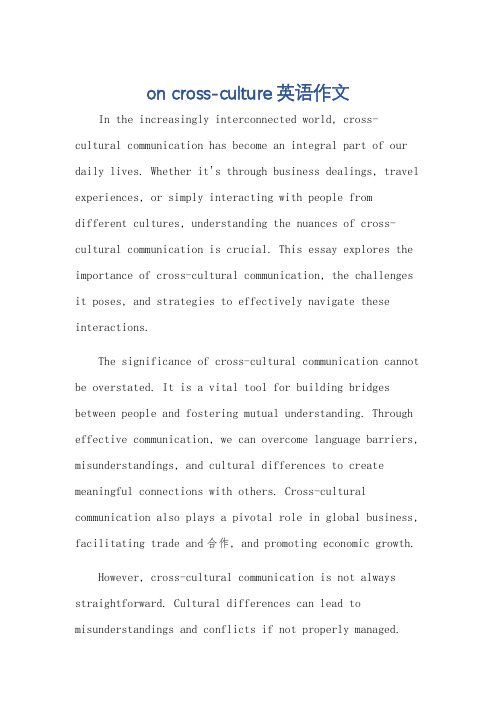
on cross-culture英语作文In the increasingly interconnected world, cross-cultural communication has become an integral part of our daily lives. Whether it's through business dealings, travel experiences, or simply interacting with people from different cultures, understanding the nuances of cross-cultural communication is crucial. This essay explores the importance of cross-cultural communication, the challenges it poses, and strategies to effectively navigate these interactions.The significance of cross-cultural communication cannot be overstated. It is a vital tool for building bridges between people and fostering mutual understanding. Through effective communication, we can overcome language barriers, misunderstandings, and cultural differences to create meaningful connections with others. Cross-cultural communication also plays a pivotal role in global business, facilitating trade and合作, and promoting economic growth. However, cross-cultural communication is not always straightforward. Cultural differences can lead to misunderstandings and conflicts if not properly managed.Language barriers, for example, can hinder effective communication, leading to misunderstandings and misinterpretations. Additionally, cultural norms and values can vary widely across different cultures, affecting how people perceive and respond to situations.To overcome these challenges, it is essential to adopt a flexible and adaptive approach to cross-cultural communication. Firstly, it is important to be aware ofone's own cultural biases and assumptions. Understanding one's own cultural lens can help us avoid projecting our own values and norms onto others. Secondly, it is crucial to actively listen and seek to understand the otherperson's perspective. By asking questions and showing empathy, we can gain a deeper understanding of their cultural background and values.Moreover, it is essential to be tolerant of cultural differences and embrace diversity. Respecting othercultures and their unique ways of communicating can foster a more inclusive and harmonious environment. Finally, it is helpful to have a basic understanding of the language and cultural norms of the other culture. This can be achievedthrough language courses, cultural immersion experiences,or simply by educating oneself through reading and research. In conclusion, cross-cultural communication is an essential skill in today's interconnected world. Itrequires awareness, flexibility, and a willingness to embrace diversity. By overcoming the challenges posed by cultural differences and adopting effective communication strategies, we can build bridges between people and createa more understanding and inclusive society.**跨文化交流:跨越鸿沟**在日益紧密相连的世界中,跨文化交流已经成为我们日常生活的重要组成部分。
Cross-cultural Communication

Cross-cultural CommunicationCross-cultural communication is a phenomenon that people of different backgrounds to communicate with a kind of circumstance, this kind of communication is the key element of culture and on your own effects.The cross-cultural communication includes religion, architecture, custom, diet, etiquette, folk communication and other aspects.How to make your cross-cultural communication more effective?Firstly, you should fully understand that culture has many impacts on all the key factors in communication. Be aware of communication barriers due to cultural differences. You must acknowledge and understand the cultural difference between different countries. This is the necessary condition to communication with people who come from different country with different backgrounds and habits. What’s more, respect is a very important target. No matter how strange one’s behavior is, respect his or hers, you will gain a beautiful smile sure.Secondly, language is necessary. Different countries have different languages what would have amount of problems. While with the progress of our society, English is more popular and general. But what should we do when one don’t know English as well? Then gesture will be a good choice, and the use of gesture is universal. Not only between people from different place, but those who are disable and can’t speak. What’s more, navy and others would use them.Thirdly, you must use appropriate ways to express. It is because the different culture that one would be misunderstand or even don’t understand any more. Besides, in communication and exchange progress, attention to communication modes, methods, can reduce the friction.Take the example of the attitude of time. Every country has different understand of the meaning of “deadline”, and in American, it means the dead line will come, must be completed. While in many other countries, it is merely a roughly point, probable around can be finish is ok, not so strict. More, some countries will ignore the time, they thought that if you did the work very well and time is sure not so important.In a word, you must know well of different culture and use suitable methods to communication, and you will do well in the cross-cultural communication.。
话题语言应用-跨文化交际

话题语言应用-跨文化交际交际用语1. 禁止和警告(prohibition and warning)Always stay …始终保持……Do not…不要……Stop! 不要!Keep away from …远离……Go away. 走开。
Don’t enter here. 别进来。
Watch out! 当心!Look out! 当心!Be careful when …当……时,小心Be quiet. 安静。
Come here. 过来。
You may not …你不可以/可能不……You’ll be fined (200) yuan. 要罚款(200)元。
Don’t smoke here. 此处禁止吸烟。
Be careful! Don’t slip. 小心点!别滑倒。
2. 义务和责任(Obligation)You must…你必须……You should never …你不应该……You’ll have to …你将不得不……You’ll need to …你将需要……拓展阅读The differences in gifts culture between Chinese and the western We can learn more about the knowledge of the culture of others, and improve our ability of communication.As we all know, different countries have different culture. “Culture is the collective programming of the mind which distinguishes the members of one category of people from another.”It is inevitable that the cultural difference has impact on business. For example ,when a company is having meeting ,the word “table”they mention inAmerican English means to put something on the agenda, but in British English it means to put something off the agenda. This example indicated how the culture affects the business.There are four cultural dimensions that were defined in Hofstede’sresearch :power distance, uncertainty avoidance, individualism and masculinity.The most significant influence in cultural difference is the power distance.“It would condition the extent to which employees accept that their boss has more power that have and the extent to which they accept that their boss’s opinions and decisions are right because he or she is the boss.”Among most oriental corporate cultures, there is hierachism reasons, great centralization, sometimes called‘power-oriented culture’, due to the historical reasons. That is a high power distance culture that mangers make the decision and superious appeal to be entitled more privileges. Their decision always close supervision positively evaluated by subordinates. In this situation, it is not be regarded if subordinates have a disagreement with their managers.In the oriental, power distance is also associated with “the family culture”. In this kind of corporate culture the manager is like the “caring father”who knows better than his subordinates what should be done and what is suitable for them .The subordinates always esteem the manager because of the manager’s age and experience. That is usually how employees get their promotion. There are both positive and negative parts in the family cultures. But sometime it is hard to get young creative employees work well because of the hierarchy. Family culture at their least effective drain the energies and loyalties of subordinates to buoy up the leader.So in family culture, the power distance can be viewed as the subordinates respect the superiors.During cross-culture negotiation, the course is the crucial obstruction. Different negotiation ways are produced by different cultures. Under the circumstances, there is a classic standpoint of procedures: exploring with no objective ,task oriented, persuading period, and sign-contract. International managers should be aware of every procedure. And during each procedure, the strategy, technique, substance, time, sequence and the focal point are different.写作运用如何通过阅读来提高写作能力语言是信息的载体,语言考试实质上考查的是信息交流的能力。
The Importance of Cross-Cultural Understanding
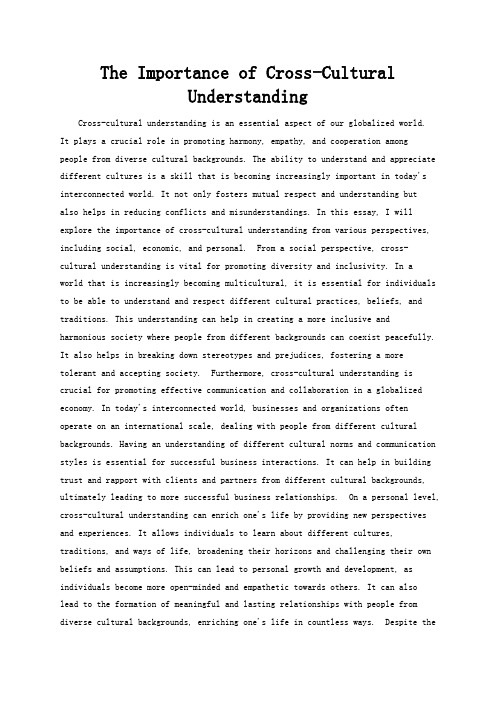
The Importance of Cross-CulturalUnderstandingCross-cultural understanding is an essential aspect of our globalized world.It plays a crucial role in promoting harmony, empathy, and cooperation amongpeople from diverse cultural backgrounds. The ability to understand and appreciate different cultures is a skill that is becoming increasingly important in today's interconnected world. It not only fosters mutual respect and understanding butalso helps in reducing conflicts and misunderstandings. In this essay, I will explore the importance of cross-cultural understanding from various perspectives, including social, economic, and personal. From a social perspective, cross-cultural understanding is vital for promoting diversity and inclusivity. In aworld that is increasingly becoming multicultural, it is essential for individuals to be able to understand and respect different cultural practices, beliefs, and traditions. This understanding can help in creating a more inclusive and harmonious society where people from different backgrounds can coexist peacefully. It also helps in breaking down stereotypes and prejudices, fostering a moretolerant and accepting society. Furthermore, cross-cultural understanding is crucial for promoting effective communication and collaboration in a globalized economy. In today's interconnected world, businesses and organizations often operate on an international scale, dealing with people from different cultural backgrounds. Having an understanding of different cultural norms and communication styles is essential for successful business interactions. It can help in building trust and rapport with clients and partners from different cultural backgrounds, ultimately leading to more successful business relationships. On a personal level, cross-cultural understanding can enrich one's life by providing new perspectives and experiences. It allows individuals to learn about different cultures, traditions, and ways of life, broadening their horizons and challenging their own beliefs and assumptions. This can lead to personal growth and development, as individuals become more open-minded and empathetic towards others. It can alsolead to the formation of meaningful and lasting relationships with people from diverse cultural backgrounds, enriching one's life in countless ways. Despite themany benefits of cross-cultural understanding, there are also challenges and barriers that can hinder its development. One of the main challenges is the presence of cultural stereotypes and prejudices, which can lead to misunderstandings and conflicts between people from different cultural backgrounds. These stereotypes are often perpetuated by the media and can lead to negative perceptions of certain cultures, hindering the development of cross-cultural understanding. Another barrier to cross-cultural understanding is the lack of exposure to different cultures. Many people may have limited opportunities to interact with individuals from different cultural backgrounds, leading to a lackof understanding and appreciation for diversity. This can be particularly challenging in homogenous societies where there is little diversity, making it difficult for individuals to develop cross-cultural understanding. In conclusion, cross-cultural understanding is essential for promoting harmony, empathy, and cooperation in our globalized world. It plays a crucial role in promotingdiversity and inclusivity, fostering effective communication and collaboration,and enriching one's personal life. While there are challenges and barriers to developing cross-cultural understanding, it is important for individuals and societies to actively work towards promoting it. By fostering mutual respect and understanding, we can create a more inclusive and harmonious world where people from diverse cultural backgrounds can coexist peacefully.。
ResearchonCulturalDifferencesbet

ResearchonCulturalDifferencesbetResearch on Cultural Differences between the WestTitle:Research on Cultural Differences between the West and East in Cross Culture CommunicationAbstract:In recent years, the cross-culture communication expanded continually, but cultural difference between thewest and east causes many barriers in Cross-Culture Communication. During east and the westCross-Culture Communication, what appears frequently is the cultural conflict. And such cases are actuallycommon, which seriously influence the smooth contact, a variety of cultural conflicts always appear in thewest and east. Such as: privacy conflict, time sense conflict, guest polite talk and others as well as diningcustom conflict. And these kinds of conflicts also reflect the cultural difference between the west and east.The ways of thinking, code of behavior, and value orientation between the west and east are the deepreasons of the cultural difference between the west and east. Therefore, we should take some measures tocultivate ability of cross-culture communication ability, to avoid the cultural conflicts. So it needs all theteachers to raise students’ Cross-Culture Communication ability in the actual English teaching. First, theteacher should change their own teaching ideas, and improve the existing teaching methods.And then teachers should widely guide the student to contact the western culture materialinformation, simultaneously both thegrantor and receiver should attach importance to raise the capability of nonverbal communication.Key Words: Culture; Cross-Culture Communication; Cultural Difference; Weatern nd Oriental Culture;Cultural Conflict。
国家开放大学《儿童心理学》章节自测参考答案

国家开放大学《儿童心理学》章节自测参考答案第一章绪论1.参照我国学制对儿童发展阶段的划分,学前儿童是指进入小学阶段学习前的儿童的统称。
其中幼儿阶段是指____的儿童。
A.4-6岁B.3-6岁C.受精卵形成到3岁2.学前儿童的发展是一个系统的整体。
但在研究和学习中,我们会可以将儿童的发展划分为生理发展、认知发展、____发展三大领域。
A.情感和社会性B.游戏C.感知觉D.道德3.中世纪以前,人们多半认为儿童是成人的雏形,是____A.成人的翻版B.环境的产物C.有自己特点的成长中的个体D.“小型成人”4.系统地对儿童进行研究开始于____。
A.十九世纪末期B.中世纪C.中世纪以前D.上世纪六十年代5.____提出了“白板说”,认为人的心灵在出生时就如一块白板,一切知识和观念及行为模式都是从经验中获得的。
他强调要培养儿童的兴趣、发展儿童的独立能力,并认为良好习惯的培养应从小开始。
A.法国思想家卢梭B.英国哲学家洛克D.达尔文6.科学儿童心理学的产生,以1882年德国生理学家和心理学家的____《儿童心理》一书的出版为标志。
A.普莱尔B.弗洛伊德C.皮亚杰D.华生7.行为主义心理学的代表人物____用学习理论进行了一些开创性的实验,____提出了精神分析理论及早期经验重要性的假设,____在瑞士开始了他对儿童认知发展的研究,这三个理论最后成为现代儿童心理学的支柱。
A.皮亚杰、埃里克森、华生B.华生、弗洛伊德、皮亚杰、埃里克森C.弗洛伊德、皮亚杰、埃里克森D.华生、弗洛伊德、皮亚杰8.强调教育必须贯彻适应自然的原则,遵循自然界的“秩序”的是____。
A.捷克教育家夸美纽斯B.英国生物学家达尔文C.英国哲学家洛克D.法国思想家卢梭9.认为儿童是“高贵的野蛮人”,他们生来就被赋于了一套有序、健康成长的普遍进程表的是____。
A.英国生物学家达尔文B.捷克教育家夸美纽斯C.英国哲学家洛克D.法国思想家卢梭10.不同学术背景的研究者开始观察、记录自己子女的发展,并以婴儿传记的形式出版,其中最具影响力的婴儿传记作者是____。
The Benefits of Cross-Cultural Exchange
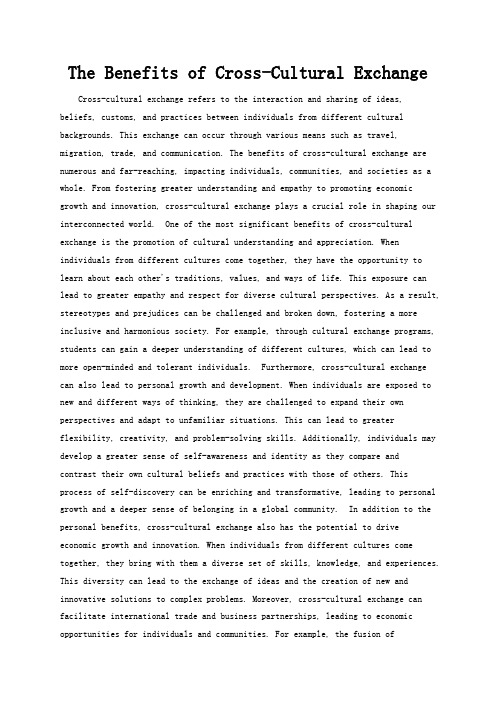
The Benefits of Cross-Cultural Exchange Cross-cultural exchange refers to the interaction and sharing of ideas, beliefs, customs, and practices between individuals from different cultural backgrounds. This exchange can occur through various means such as travel, migration, trade, and communication. The benefits of cross-cultural exchange are numerous and far-reaching, impacting individuals, communities, and societies as a whole. From fostering greater understanding and empathy to promoting economic growth and innovation, cross-cultural exchange plays a crucial role in shaping our interconnected world. One of the most significant benefits of cross-cultural exchange is the promotion of cultural understanding and appreciation. When individuals from different cultures come together, they have the opportunity to learn about each other's traditions, values, and ways of life. This exposure can lead to greater empathy and respect for diverse cultural perspectives. As a result, stereotypes and prejudices can be challenged and broken down, fostering a more inclusive and harmonious society. For example, through cultural exchange programs, students can gain a deeper understanding of different cultures, which can lead to more open-minded and tolerant individuals. Furthermore, cross-cultural exchange can also lead to personal growth and development. When individuals are exposed to new and different ways of thinking, they are challenged to expand their own perspectives and adapt to unfamiliar situations. This can lead to greater flexibility, creativity, and problem-solving skills. Additionally, individuals may develop a greater sense of self-awareness and identity as they compare andcontrast their own cultural beliefs and practices with those of others. This process of self-discovery can be enriching and transformative, leading to personal growth and a deeper sense of belonging in a global community. In addition to the personal benefits, cross-cultural exchange also has the potential to drive economic growth and innovation. When individuals from different cultures come together, they bring with them a diverse set of skills, knowledge, and experiences. This diversity can lead to the exchange of ideas and the creation of new and innovative solutions to complex problems. Moreover, cross-cultural exchange can facilitate international trade and business partnerships, leading to economic opportunities for individuals and communities. For example, the fusion ofdifferent culinary traditions in the food industry has led to the creation of new and exciting cuisines, driving economic growth and entrepreneurship. Another important benefit of cross-cultural exchange is the preservation and promotion of cultural heritage. As individuals from different cultures interact and share their traditions, there is a greater opportunity for the preservation of cultural practices and customs that may be at risk of being lost. Furthermore, cross-cultural exchange can lead to the revitalization of traditional art forms, music, and craftsmanship, ensuring that these cultural treasures are passed down tofuture generations. For example, the exchange of traditional dance and music between different cultures can lead to the preservation and promotion of these art forms on a global scale. Moreover, cross-cultural exchange can also have a positive impact on global peace and diplomacy. When individuals from different cultures come together in a spirit of mutual respect and understanding, it can help to bridge divides and promote peaceful coexistence. By fostering dialogue and cooperation between different cultural groups, cross-cultural exchange can contribute to the resolution of conflicts and the promotion of peace on both a local and global scale. For example, cultural exchange programs between countries can help to build trust and understanding, laying the foundation for diplomatic relations and cooperation. In conclusion, the benefits of cross-cultural exchange are vast and multifaceted, impacting individuals, communities, and societies in numerous ways. From fostering greater understanding and empathy to promoting economic growth and innovation, cross-cultural exchange plays a crucial role in shaping our interconnected world. By promoting cultural understanding and appreciation, driving personal growth and development, driving economic growth and innovation, preserving and promoting cultural heritage, and contributing to global peace and diplomacy, cross-cultural exchange has the power to create a more inclusive, harmonious, and prosperous global community. As we continue to navigate an increasingly interconnected world, it is essential to recognize and celebrate the many benefits of cross-cultural exchange.。
cross-cultural gap的作文
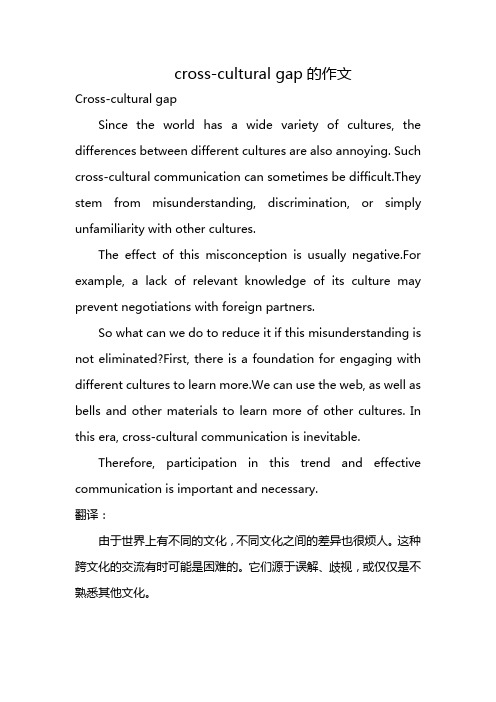
cross-cultural gap的作文Cross-cultural gapSince the world has a wide variety of cultures, the differences between different cultures are also annoying. Such cross-cultural communication can sometimes be difficult.They stem from misunderstanding, discrimination, or simply unfamiliarity with other cultures.The effect of this misconception is usually negative.For example, a lack of relevant knowledge of its culture may prevent negotiations with foreign partners.So what can we do to reduce it if this misunderstanding is not eliminated?First, there is a foundation for engaging with different cultures to learn more.We can use the web, as well as bells and other materials to learn more of other cultures. In this era, cross-cultural communication is inevitable.Therefore, participation in this trend and effective communication is important and necessary.翻译:由于世界上有不同的文化,不同文化之间的差异也很烦人。
- 1、下载文档前请自行甄别文档内容的完整性,平台不提供额外的编辑、内容补充、找答案等附加服务。
- 2、"仅部分预览"的文档,不可在线预览部分如存在完整性等问题,可反馈申请退款(可完整预览的文档不适用该条件!)。
- 3、如文档侵犯您的权益,请联系客服反馈,我们会尽快为您处理(人工客服工作时间:9:00-18:30)。
2.1The Difference between Family Education Contents
• Chinese family education puts great emphasis on children's all-round development - moral, intellectual, physical and aesthetical. • American family education is rich in content and attaches importance to children's harmonious development of physical power, cognition, sociality, language and emotion, which is called competenceoriented education.
Suyun,woo, Jingmei,woo
Yingying, Lena
Lindo Jong, Waverly Jong
An-Mei Hsu, Rose Hsu Jordan
The main content
Four mothers were suffered tortures in old China ,so they finally forced to far from home to the United States to live. Their daughters were born in the US and affected by the culture and education of the US, which lead to a series of clashes between mothers and daughters. but there also are the cultural collisions and blends.
2.4The Difference between Family Education Results
• American Children: independent, competitive and able to adapt to new surroundings • Chinese Children: superior in grade points, are expected to be talents, children’s interests and creativity are ignored
3.2 Different Economic Patterns
• The America: advanced productive force, a booming economy, light living stress, having a broad range of choices and open careers.
1.1 The Importance of Family Education
Family,as the cell of society,is the first place that children receive education and the first unit that the children get in touch with the society.
2.2The Difference between Family Education Methods
• In general, the education method of American families is equal and democratic. Parents respect children and treat them as equal and independent family members.
The case study of the Joy Luck Club 喜福会
• The main characters and content
• Differences in values between Chinese and American family education • A comparison between Chinese and American family education
Differences in values between Chinese and American family education
中国
团 家 个 体 庭 人 团 个 家
西方
体 人 庭
中国文化传统中各因 素比例
西方文化传统中各因素 比例 (葛树慧,2009)
• 一个传统社会中的中国人,他的身份、地位、价 值、权力义务和责任,都是和他的家庭和家族紧 密联系在一起的,一损俱损,一荣俱荣,一个人 如果家庭的“门第”高,家庭是“名门望族”, 他的地位也就高,价值也就大。 (易中天,1996)
3.3.2 Different Modes of Thinking
• Americans are rational. The obligations of fostering and educating children are not starting from the interest of the whole families and themselves. • Chinese treat family relationship on the basis of affection. Most Chinese parents educate their children out of the consideration of supporting of their old age and realizing their own ambitions, since they regard children as their personal properties.
• However,Chinese parents hold that they are their children’s elders. Parents regard their children as their private property.
2.3The Difference between Family Education Objectives
The Causes for the Differences
3.1 Different Historical Background The American: immigrant , short history, multicultural values
The China: long history, conservative, old restraints and small-scale peasant economy
1.2 The Aims of Family Education
• help children understand life and society, enrich their experience and lay the foundation of their future independent life • help the children have a healthy personality • develop children's morality • help the children have a healthy body • guide children in their acquisition of knowledge
• Chinese people are particular about the commonness that the collective interest is superior to the individual's. In the family, parents treat their children as the extending of their own values. Children are the whole content of their life whose future life is designed by their parents in advance.
Show off due to daughter’s championship
传统道德因素的比例表
人格气质 均值 4.05 3.92 3.87 标准差 1.561 2.020 1.532
气节 忠孝 仁爱 理智
勤俭 进取 侠义 中庸
3.75
3.10 2.91 2.33 0.01
2.170
2.362 2.182 2.571 3.488
• The China: an academic-oriented society with a backward economy, heavy living stress, tending to place the happiness of their whole life on one vocation.
3.3 Different Cultural Traditions
• 3.3.1 Different Value Orientations
American people emphasize the individual interest and self achievement, whose cultural core is man-oriented. In the family, an individual has the highest right and is independent of the family relationship.
3.3 Different Cultural Traditions
